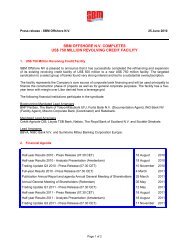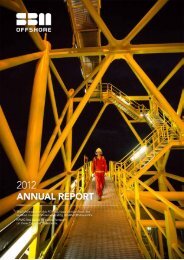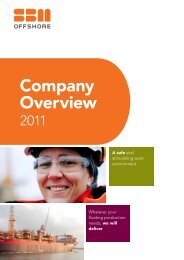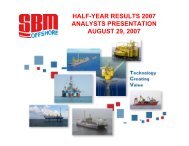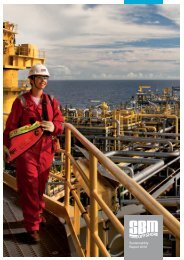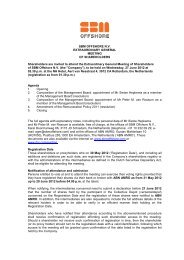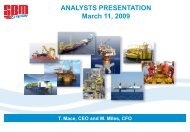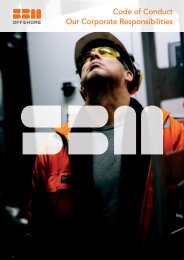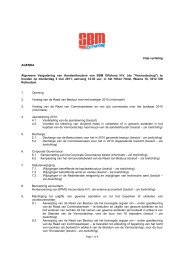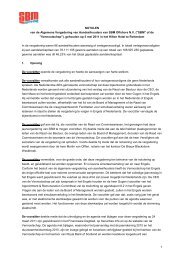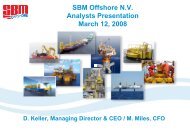Annual Report 2010 - SBM Offshore
Annual Report 2010 - SBM Offshore
Annual Report 2010 - SBM Offshore
You also want an ePaper? Increase the reach of your titles
YUMPU automatically turns print PDFs into web optimized ePapers that Google loves.
Financial Review / Financial Statements <strong>2010</strong><br />
When significant parts of an item of property, plant and<br />
equipment have different useful lives, those components<br />
are accounted for as separate items of property,<br />
plant and equipment.<br />
The assets’ residual values are reviewed and adjusted,<br />
if appropriate, at each balance sheet date. An asset’s<br />
carrying amount is written down immediately to its<br />
recoverable amount if the asset’s carrying amount is<br />
higher than its estimated recoverable amount.<br />
Gains and losses on disposals are determined by<br />
comparing proceeds (less attributable costs) with the<br />
carrying amount. These are included in the income<br />
statement.<br />
Intangible assets<br />
Goodwill<br />
Goodwill represents the excess of the cost of an acquisition<br />
over the fair value of the Company’s share of the<br />
net identifiable assets of the acquired subsidiary at<br />
the date of the acquisition. All business combinations<br />
are accounted for by applying the purchase method.<br />
Goodwill on acquisition of subsidiaries is included in<br />
‘intangible assets’. In respect of business acquisitions<br />
occurring after 1 January 2004, goodwill represents<br />
the difference between the cost of the acquisition and<br />
the fair value of the net identifiable assets acquired. In<br />
respect of acquisitions prior to this date, goodwill is<br />
included on the basis of its deemed cost, which is the<br />
amount recorded under Dutch GAAP.<br />
Goodwill is tested annually for impairment and carried<br />
at cost less accumulated impairment losses.<br />
Impairment losses on goodwill are not reversed. Gains<br />
and losses on the disposal of an entity include the carrying<br />
amount of goodwill relating to the entity sold.<br />
Goodwill is allocated to cash-generating units for the<br />
purpose of impairment testing. The allocation is made<br />
to those cash-generating units or groups of cashgenerating<br />
units that are expected to benefit from the<br />
business combination in which the goodwill arose.<br />
The cash-generating units are the 7 identified operating<br />
units.<br />
120 <strong>SBM</strong> <strong>Offshore</strong> – <strong>Annual</strong> <strong>Report</strong> <strong>2010</strong><br />
Patents<br />
Separately acquired patents are shown at historical<br />
cost. Patents acquired in a business combination are<br />
recognised at fair value at the acquisition date. Patents<br />
have a finite useful life and are carried at cost less<br />
accumulated amortisation. Amortisation is calculated<br />
using the straight-line method to allocate the cost of<br />
patents over their estimated useful lives of 15 years.<br />
The patents are tested annually for impairment.<br />
Research and development<br />
Research expenditure is recognised as an expense<br />
when incurred. Costs incurred on development projects<br />
(relating to the design and testing of new or improved<br />
products) are recognised as an intangible asset when<br />
the following criteria are fulfilled:<br />
• it is technically feasible to complete the intangible<br />
asset so that it will be available for use or sale;<br />
• management intends to complete the intangible<br />
asset and use it or sell it;<br />
• there is an ability to use or sell the intangible asset;<br />
• it can be demonstrated how the intangible asset will<br />
generate probable future economic benefits;<br />
• adequate technical, financial and other resources<br />
to complete the development and to use or sell the<br />
intangible assets are available;<br />
• the expenditure attributable to the intangible asset<br />
during its development can be reliably measured.<br />
Other development expenditures that do not meet<br />
these criteria are recognised as an expense as<br />
incurred. Development costs previously recognised as<br />
an expense are not recognised as an asset in a subsequent<br />
period. Capitalised development costs are<br />
amortised from the point at which the asset is ready<br />
for use on a straight-line basis over its useful life, not<br />
exceeding 5 years.<br />
Impairment of non-financial assets<br />
Assets that have an indefinite useful life, for example<br />
goodwill, are not subject to amortisation and are<br />
tested annually for impairment and whenever events<br />
or changes in circumstances indicate that the carrying<br />
amount may not be recoverable. Assets that are<br />
subject to amortisation or depreciation are tested for<br />
impairment whenever events or changes in circumstances<br />
indicate that the carrying amount may not be<br />
recoverable. An impairment loss is recognised for the



